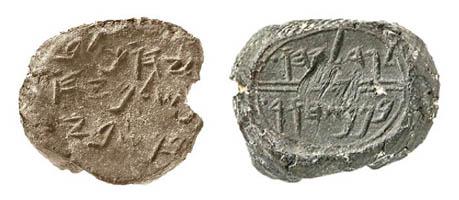Jeremiah, Prophet of the Bible, Brought Back to Life
Clay bullae from the City of David, Jerusalem, provide new evidence for Biblical figures
Source - http://www.biblicalarchaeology.org/daily/biblical-artifacts/artifacts-and-the-bible/jeremiah-prophet-of-the-bible-brought-back-to-life/

These clay bullae (seal impressions), discovered by archaeologist Eilat Mazar during her excavations of the City of David, Jerusalem, bear the names of two royal ministers mentioned in the Bible’s story of Jeremiah, prophet of the Old Testament. Photos by Gaby Laron, The Institute of Archaeology, The Hebrew University.
The relationship between archaeology and the Bible is not always an easy one, but sometimes they come together in striking agreement as witnesses to history. Two small clay bullae (seal impressions) found in the course of Eilat Mazar’s City of David, Jerusalem, excavations are bringing Jeremiah, prophet of the last kings of Judah, back to life.
The first of the clay bullae, which surfaced during Mazar’s excavation of what may be King David’s palace, bears the name “Yehuchal [or Jehucal] ben Shelemyahu [Shelemiah]” (pictured above left). The second was found in the First Temple period strata underneath what has been identified as Nehemiah’s Northern Tower, just a few yards away from the first, and reads “Gedalyahu [Gedaliah] ben Pashur” (pictured above right).
These two men are mentioned together in the Bible as ministers of King Zedekiah (597–587 B.C.E.). As the Babylonians closed in on Jerusalem during the last years of the First Temple period, Jeremiah, prophet to Judah’s last kings, advised Zedekiah and the people of the city to surrender to Nebuchadnezzar’s men so that their lives and city might be spared. But not everyone liked Jeremiah’s message, including Gedaliah son of Pashur and Jehucal son of Shelemiah. According to Jeremiah 38:1–13, the two ministers had Jeremiah thrown into a pit because they did not like the message of surrender he was preaching to the people of Jerusalem.
Biblical Archaeology Review readers have already been introduced to these tiny but amazing clay bullae in recent articles by Hebrew University archaeologist Eilat Mazar about her excavations in the City of David, Jerusalem,* but now visitors to Edmond, Oklahoma, can see them at their world premiere at the Armstrong Auditorium on the campus of Herbert W. Armstrong College. The Seals of Jeremiah’s Captors Discovered exhibit, which continues through October 16, 2012, features the two clay bullae as well as dozens of ceramic artifacts from Jerusalem during the First Temple period—including figurines, royal seal impressions, and one of the largest ancient vessels ever found in Jerusalem.
Herbert W. Armstrong College provided support for Eilat Mazar’s City of David excavations.
Notes
* See “Jeremiah’s Opponents,” sidebar to Eilat Mazar, “The Wall That Nehemiah Built,” Biblical Archaeology Review, March/April 2009; and Eilat Mazar, “Did I Find King David’s Palace?” Biblical Archaeology Review, January/February 2006.
Based on Strata, Exhibit Watch, “Jeremiah Brought Back to Life,” Biblical Archaeology Review, March/April 2012.